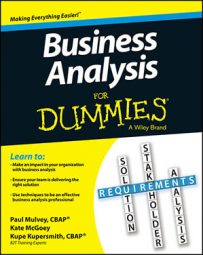You may or may not need to include a detailed cost/benefit analysis for each alternative in the business case. Some opportunities may warrant having just the final recommendation fully documented in this section. The audience and the opportunity drive the level and complexity of the details required.
A good rule of thumb is that, if the recommendation is obvious to and will mostly be accepted easily by all individuals responsible for approval, you can simply include the details for only the final recommendation. However, if two or more options are viable solutions, providing more detail in this section gives the audience members the additional information they require to make an informed decision.
Process-related impacts
Review your processes to identify the elements that may change because they’re directly impacted by the problem or solution. New processes may be identified, or some existing processes may be eliminated. You can see an example of a change in a process from current state to future state; the third tier expands, and the fourth tier is eliminated.
![[Credit: Illustration by Wiley, Composition Services Graphics]](https://www.dummies.com/wp-content/uploads/390535.image0.jpg)
Identify outcomes and critical workflows needed for the change, if possible. As much as you can at this stage, determine the specific workflows and activity steps that may be impacted; doing so helps substantially in quantifying the cost/benefits.
If you can identify the actual costs/benefits of the current as-is process and the estimated costs/benefits of the to-be process, you and your audience can evaluate the recommendation objectively. Changes to processes may include savings in efficiencies or effectiveness, savings due to activities being eliminated, or costs for new activities. The actual costs or savings realized depend on the option being evaluated.
For example, say that an opportunity is proposed to change the production and distribution of student class certificates so that the students receive an electronic certificate rather than a printed one. The ongoing cost differences between these alternatives include those listed below.
| As-Is | To-Be | Difference | |
|---|---|---|---|
| Time to print certificates for each class | 2 hours | 0 hours | 2 hours |
| Salary of personnel to produce certificates | $15/hour | $15/hour | $0 |
| Subtotal of salary cost | $30 | $0 | $30 |
| Cost of materials and shipping | $50 | $0 | $50 |
| Net (cost)/benefit of automating certificates | ($80) | $0 | $80 |
For this scenario, you need to find out the potential customer satisfaction of students receiving a printed color certificate versus an electronic one. If they’re unhappy with the electronic certificate but won’t take any action, the financial impact is zero. However, if they avoid future classes or tell others to because of this change, you have to include the estimated negative impact in the analysis.
People-related impacts
The business objectives of an initiative may impact the people in the organization or target market. To identify people-related impacts, consider the following:
Who or how many are impacted: Look at the problem or opportunity as well as the solution to identify the people who are impacted.
What the transition from the as-is to the to-be means for them: Identify whether the impacted individuals will have to learn new processes or skills to perform the new process and whether they’ll remain employed or be transferred to a different business area.
After you identify the change impacts to people, you can quantify the related tangible and intangible costs and benefits, which may include all costs associated with labor, such as salary, benefits, and management support costs. Only consider the ongoing or operational costs of the change as related to people at this point.
System-related impacts
You may find in the business case stage of a project that a specific technology hypothesis is in place for the solution. Considerations when analyzing impacts to the target system(s) include
System user/production
Outsourced contracts
Operational support
Hardware
Software
Licenses
Maintenance fees
Network cost
The cost to develop the new system or changes are included in the one-time implementation costs and aren’t part of the ongoing/operational costs.
How to quantify implementation costs for business analysis
Implementation costs are one-time costs associated with a brand new initiative or a change to an existing one. These costs include — on a broad level — the cost of developing or producing the opportunity as well as the transition costs to move from the as-is to the to-be.
Just as you identify the process, people, and systems for the ongoing/operational costs, you can use these categories when analyzing the implementation costs:
Process change costs may require organizational readiness assessments or a change management plan, and that adds cost and time.
People-related implementation costs include costs of managing the change and training (such as communication programs) and human resource activities to relocate, hire, or terminate personnel.
System-related implementation costs include the development or enhancement to the technology and any simulation, prototypes, or pilots required during development.
The implementation costs of switching from printed class certificates to electronic certificates include the following at a minimum:
Analysis time to design the certificates
Development cost
Testing costs
Assuming these costs total $15,000 and the cost savings per class is $80, the change will have a payback after 188 classes. The automated certificate should be maintenance free for at least 2 years, with minimal changes required to the format expected every third year at a cost of $500 per change.
The organization holds approximately 200 classes per year; below is the cost/benefit recommendation at a high level for the next 6 years:
| Year 1 | Year 2 | Year 3 | Year 4 | Year 5 | Year 6 | |
|---|---|---|---|---|---|---|
| Implementation costs | $15,000 | |||||
| Maintenance costs | $500 | $500 | ||||
| Ongoing (costs)/benefit | $16,000 | $16,000 | $16,000 | $16,000 | $16,000 | $16,000 |
| Net realized | $1,000 | $16,000 | $15,500 | $16,000 | $16,000 | $15,500 |

